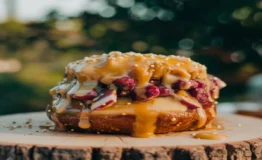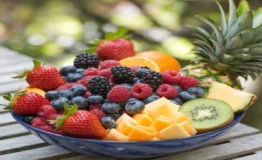Discover the world of Swiss baking with our gipfeli recipe. This Swiss croissant offers a flaky texture, crisp edges, and a unique flavor that sets it apart from the French croissant, making it a delightful treat to enjoy.
Join us as we learn how to make homemade gipfeli. This pastry brings warmth and happiness with every bite. It’s a journey into the art of Swiss baking.
Key Takeaways:
- The gipfeli is a staple of Swiss baking known for its flaky texture.
- It differs from traditional French croissants in flavor and texture.
- This article provides a comprehensive gipfeli recipe for making these pastries at home.
- Explore various filling options to personalize your Swiss croissant.
- Perfect for brunch or as a delightful dessert, gipfeli can be served in multiple ways.
Unveiling the Swiss Croissant: An Introduction to Gipfeli recipe
The definition of gipfeli often gets mixed up with traditional Swiss croissants. But gipfeli is different because it’s lighter and less buttery. This makes it a special pastry in Swiss baking culture.
Gipfeli has a flaky texture and a light taste. It goes well with many toppings and fillings, making breakfast special. Its flexibility makes it great for both sweet and savory dishes, which is why it’s loved in Switzerland.
Gipfeli is a key part of Swiss baking culture. It shows the importance of quality ingredients and traditional baking. Every bite takes you to the alpine valleys, where tradition and creativity come together. Gipfeli’s history and modern appeal keep it popular with both locals and visitors.
What Makes Gipfeli Unique?
Gipfeli stands out because of its special texture and taste. These qualities come from careful baking and the right mix of ingredients.
The Texture and Flavor Profile
Gipfeli has a crisp outside and a soft, airy inside. This mix of textures is very pleasing. Its taste is subtle yet fulfilling, making it great with many toppings.
It goes well with sweet or savory toppings. Gipfeli keeps its own taste while boosting the flavor of what you add to it.
Differences Between Gipfeli and Traditional Croissants
Swiss pastry, like gipfeli, is different from French croissants. Gipfeli uses less butter, making it lighter. The way it’s shaped sets it apart, keeping its form when baked.
This shows how different regions make their pastries. It highlights the unique qualities of gipfeli.
The Rich History of Gipfeli in Swiss Culture
The history of gipfeli is deeply rooted in Switzerland’s cultural heritage. It comes from the German word “Gipfel,” meaning peak. This pastry reflects the stunning Swiss Alps. Over time, gipfeli has become a beloved part of Swiss cuisine.
From ‘Gipfel’ to Gipfeli: The Evolution of a Pastry
Once a treat for special events, gipfeli now is a common morning food. Its dough is made with care, creating layers that are light and flaky. This change shows how gipfeli has become a symbol of Swiss life.
Traditional Breakfasts and Gipfeli’s Place at the Table
In Swiss breakfasts, gipfeli is a key item, enjoyed with coffee or tea. It has become versatile, offering sweet and savory fillings for everyone. Gipfeli symbolizes bringing people together, a core part of Swiss culture.
Gathering Your Ingredients for the Perfect Gipfeli Recipe
Creating authentic gipfeli needs careful attention to detail. You must pick the right ingredients for that perfect flaky texture and rich taste. Knowing what each ingredient does can make baking much better.
Essential Ingredients for Authentic Gipfeli
All-purpose flour is key for the pastry’s structure. Active dry yeast makes the gipfeli rise. Warm milk with sugar wakes up the yeast, and unsalted butter adds a rich taste. A pinch of salt balances the sweetness and boosts flavor. Each ingredient is crucial for a great gipfeli.
Alternative Ingredients for Variations
If you have dietary restrictions, don’t worry. You can use gluten-free flour instead of all-purpose flour. Almond or oat milk can replace regular milk without affecting the texture. Plant-based butter is also an option for vegans. These changes let everyone enjoy this Swiss treat.
How to Make Gipfeli: Step-by-Step Guide
Making perfect gipfeli takes a few key steps for a light, flaky texture. This guide will walk you through activating yeast and kneading dough. These steps are crucial for a great gipfeli.
Activating the Yeast for Fluffy Gipfeli
Start by activating yeast, which is key for a good rise. Mix warm milk with sugar and add yeast on top. Let it sit for 5 to 10 minutes until you see froth. This means the yeast is alive and ready to help the dough rise.
Kneading the Dough to Pastry Perfection
After activating the yeast, it’s time to knead the dough. Kneading helps develop gluten, which gives the dough structure and stretch. Mix the yeast mix with flour, salt, and other ingredients. Knead for 10 minutes until it’s smooth and elastic. Getting the dough right is what makes gipfeli special.
Mastering the Art of Incorporating Butter into Gipfeli Dough
Creating the perfect gipfeli is all about the art of butter laminating. This process makes the pastry flaky and delightful. It’s key for any baker wanting that special gipfeli taste.
Techniques for Effective Butter Laminating
For the best results, use cold, softened butter. This keeps the butter in the dough without melting. It’s important for layering. Using techniques like the book fold and letter fold helps mix the butter into the dough well.
As you layer the dough, keep each fold precise. Each turn adds important layers for flakiness. Keep surfaces floured to prevent sticking and make the process smoother. Mastering these steps will make your gipfeli stand out.
The Secret Behind Shaping Gipfeli’s Signature Crescent
Shaping gipfeli needs precise techniques for that iconic crescent look. Start by rolling out the dough into a flat layer. Keeping it even is key for even baking.
Next, cut the dough into triangles, about two to three inches wide. Cutting accurately is crucial for the final shape. Roll each triangle from the wide end to the tip, making a crescent shape. Don’t stretch the dough too much to keep the buttery layers together.
Even shapes bake evenly and look great. The way you shape gipfeli affects its look and texture. With practice, you’ll make perfect, flaky gipfeli every time.
Baking Your Gipfeli to Perfection
To get the perfect gipfeli, pay close attention to the baking process. Make sure your oven is ready to help the dough rise and get that flaky texture. Begin by heating your oven to the right temperature before putting in your gipfeli. This is key for a great bake.
Preheating the Oven and Preparing for Baking
Heat your oven to 375°F (190°C) for the best baking results. This temperature helps make a pastry that’s evenly cooked and golden-brown. While the oven warms up, put parchment paper on your baking sheet to stop the gipfeli from sticking. A ready baking surface means better heat spread and a better gipfeli texture.
Tips for Perfecting Your Baking Technique
Before baking, brush your gipfeli with an egg wash for shine and that golden look. For top-notch baking, watch the time. Bake for 15-20 minutes, watching to avoid over-browning. You should end up with a treat that’s crisp outside and light inside, making it hard to resist.
Exploring Variations in Your Delicious Gipfeli Recipe
Gipfeli is versatile, inviting bakers to experiment with many flavors. You can try different sweet or savory fillings. Sweet fillings can make your baking fun and exciting.
Sweet Fillings: Almond Paste and Nutella Variations
Almond paste and Nutella are top picks for sweet fillings. Almond paste brings a rich, nutty taste that goes well with the buttery dough. Nutella adds a creamy and chocolatey flavor that kids and adults love.
These fillings not only taste great but also look beautiful. They make your treats stand out.
Savory Options: Cheese and Ham Fillings
If you like savory, try cheese and ham fillings. Melted cheese with thin slices of ham makes a tasty filling. It’s perfect for breakfast or a snack.
Using different cheeses like Gruyère or cheddar makes your gipfeli exciting. It’s a great way to mix things up.
Serving Suggestions for Your Delicious Homemade Gipfeli Recipe
Gipfeli is perfect with the right spreads and drinks. Think about pairing it with various spreads and beverages to make it even more enjoyable.
Perfect Pairings: Spreads and Beverages
For a classic morning, spread high-quality butter or almond paste on your gipfeli. Fruit jams like strawberry or apricot add a sweet touch. Or, try tangy cream cheese or aged Swiss cheese for a savory taste.
These spreads make the flavor richer and improve brunch with coffee or orange juice.
Creative Serving Ideas for Brunch or Dessert
Gipfeli is great for any event. For brunch, put gipfeli on a platter with fresh fruits and cheeses. This looks inviting and lets guests mix flavors.
For dessert, pair gipfeli with vanilla ice cream and chocolate sauce. These ideas will wow your guests and show off gipfeli’s versatility.
Tips for Make-Ahead gipfeli recipe
Preparing Gipfeli in advance saves time and ensures you can enjoy fresh pastries whenever you want. By following make-ahead tips, bakers can easily enjoy Gipfeli with little effort. Here’s how to prepare the dough early and freeze unbaked Gipfeli.
Prepare the Dough in Advance
It’s wise to make the dough early for easy meal prep. Use your favorite recipe to mix the dough, then divide it as needed. Let the dough rise, then shape it into the shapes you like. Wrap the Gipfeli well in plastic or parchment paper to keep it fresh.
This keeps the texture and taste until you’re ready to bake.
Freezing Unbaked Gipfeli for Future Enjoyment
Freezing unbaked Gipfeli is great for busy mornings or surprise guests. Put the pastries on a parchment-lined baking sheet and freeze them until they’re hard. Then, move them to airtight containers or freezer bags, remembering to date them.
This way, you can bake them straight from the freezer for warm, tasty Gipfeli anytime.
Conclusion: gipfeli recipe
As we finish our journey into the world of gipfeli, it’s clear this Swiss pastry is more than a sweet treat. It’s a celebration of tradition and skill. This guide shows the steps and the love Swiss baking brings.
Making gipfeli is about simple, effective techniques. Both new and skilled bakers can find joy in it. Every bite of the golden, flaky gipfeli brings out the kitchen magic. It’s perfect fresh from the oven or with your favorite drink.
So, why not start your gipfeli adventure? Dive into Swiss baking and let the flavors spark your creativity. Mastering this recipe improves your skills and creates moments to share with loved ones.
FAQ about gipfeli recipe:
What is gipfeli?
Gipfeli is a Swiss pastry that’s like a croissant but lighter and flakier. It has less butter, making it airy and perfect with sweet or savory toppings. It’s a big part of Swiss breakfasts.
How do gipfeli differ from French croissants?
Gipfeli are less buttery, making them lighter and airier than French croissants. They have a unique way of folding and baking that sets them apart.
Can I use alternative ingredients for making gipfeli?
Yes, you can swap out traditional ingredients for dietary needs. For example, use gluten-free flour or coconut oil for a dairy-free version.
What are the essential ingredients for making authentic gipfeli?
You need all-purpose flour, active dry yeast, warm milk, unsalted butter, sugar, and salt for real gipfeli. Each ingredient is key for the flaky texture and delicate taste.
How can I ensure my gipfeli have the perfect flaky texture?
For flaky layers, use cold, softened butter in the dough. Roll and fold it well. Also, shape and bake at the right temperature for the best result.
What are some popular fillings for gipfeli?
Favorites include almond paste or Nutella for sweet fillings, and cheese and ham for savory. Feel free to try different flavors you like.
How should I serve gipfeli?
Serve gipfeli plain or with butter or jam. They’re great for brunch or dessert, and pair well with coffee or tea.
Can I prepare gipfeli in advance?
Yes! Make the dough ahead and freeze the gipfeli. Then, bake them fresh whenever you want, saving time.
What is the history of gipfeli in Swiss culture?
“Gipfeli” comes from “Gipfel,” the German word for peak, showing Switzerland’s mountains. Over time, gipfeli became a favorite breakfast treat enjoyed all day.






